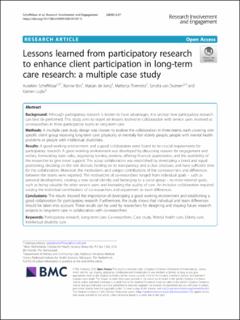| dc.contributor.author | Scheffelaar, Aukelien | |
| dc.contributor.author | Bos, Nanne | |
| dc.contributor.author | de Jong, Marjan | |
| dc.contributor.author | Triemstra, Mattanja | |
| dc.contributor.author | van Dulmen, Sandra | |
| dc.contributor.author | Luijkx, Katrien | |
| dc.date.accessioned | 2021-03-25T10:56:58Z | |
| dc.date.available | 2021-03-25T10:56:58Z | |
| dc.date.created | 2021-02-21T17:08:06Z | |
| dc.date.issued | 2020 | |
| dc.identifier.citation | Scheffelaar, A., Bos, N., de Jong, M., Triemstra, M., van Dulmen, S. & Luijkx, K. (2020). Lessons learned from participatory research to enhance client participation in long-term care research: a multiple case study. Research Involvement and Engagement, 6, 27. | en_US |
| dc.identifier.issn | 2056-7529 | |
| dc.identifier.uri | https://hdl.handle.net/11250/2735498 | |
| dc.description.abstract | Background: Although participatory research is known to have advantages, it is unclear how participatory research can best be performed. This study aims to report on lessons learned in collaboration with service users involved as co-researchers in three participatory teams in long-term care.
Methods: A multiple case study design was chosen to explore the collaboration in three teams, each covering one specific client group receiving long-term care: physically or mentally frail elderly people, people with mental health problems or people with intellectual disabilities.
Results: A good working environment and a good collaboration were found to be crucial requirements for participatory research. A good working environment was developed by discussing reasons for engagement and wishes, formulating basic rules, organizing training sessions, offering financial appreciation, and the availability of the researcher to give travel support. The actual collaboration was established by developing a bond and equal positioning, deciding on the role division, holding on to transparency and a clear structure, and have sufficient time for the collaboration. Moreover, the motivations and unique contributions of the co-researchers and differences between the teams were reported. The motivations of co-researchers ranged from individual goals – such as personal development, creating a new social identity and belonging to a social group – to more external goals, such as being valuable for other service users and increasing the quality of care. An inclusive collaboration required valuing the individual contributions of co-researchers and adjustment to team differences.
Conclusions: The results showed the importance of developing a good working environment and establishing a good collaboration for participatory research. Furthermore, the study shows that individual and team differences should be taken into account. These results can be used by researchers for designing and shaping future research projects in long-term care in collaboration with co-researchers. | en_US |
| dc.language.iso | eng | en_US |
| dc.rights | Navngivelse 4.0 Internasjonal | * |
| dc.rights.uri | http://creativecommons.org/licenses/by/4.0/deed.no | * |
| dc.title | Lessons learned from participatory research to enhance client participation in long-term care research: A multiple case study | en_US |
| dc.type | Peer reviewed | en_US |
| dc.type | Journal article | en_US |
| dc.description.version | publishedVersion | en_US |
| dc.rights.holder | © The Author(s), 2020. | en_US |
| dc.source.volume | 6 | en_US |
| dc.source.journal | Research Involvement and Engagement | en_US |
| dc.identifier.doi | https://doi.org/10.1186/s40900-020-00187-5 | |
| dc.identifier.cristin | 1892118 | |
| dc.source.articlenumber | 27 | en_US |
| cristin.ispublished | true | |
| cristin.fulltext | original | |
| cristin.qualitycode | 1 | |

